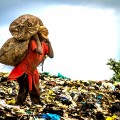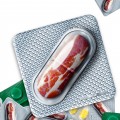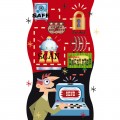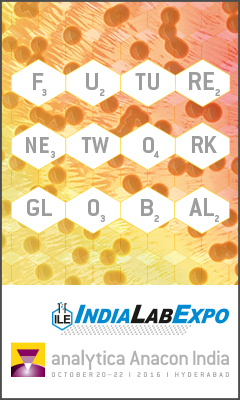Metal-organic frameworks: record-breakers in porosityThe search for endless emptiness - von Prof. Dr Stefan Kaskel
In recent years, metal-organic frameworks have been setting one record after another in relation to specific surface area, with over 7,000m2/g now being achievable. Their modular construction and the large number of functionalities that can be built into the lattice make them both interesting and highly promising for a wide variety of applications.

Developing bio-based carrier systems for gene transferGenes on sugar - von Prof. Dr Dagmar Fischer, Prof. Dr Thomas Heinze
The targeted transport of DNA and RNA using vectors (mostly made from synthetic polymers) in cell cultures has become part of routine practice in biological R&D – a fact highlighted by the multitude of commercial kits now available. To date, however, obstacles relating to use in patients have beset many laboratory studies and – in particular – the transfer to clinical practice. In many cases, such issues are related to safety concerns and limited...
 From fat droplets in plant cells to novel foodsFunctional nanoparticles - von Dr Birgitta Zielbauer, Prof. Behic Mert, Prof. Thomas Vilgis
Occurring naturally in oilseeds, oleosomes are particles with special properties. Depending on the plant variety, their size ranges from microns down into the nanoscale. These particles, with their protein-functionalized surfaces, are structurally very stable indeed. This makes them relevant for fundamental research and pharmacology, and also for innovative applications in food science.
 How biopharmaceutical drug substances use the nose as a pathway to the brainBehind the doorman’s back - von Johannes Flamm, Stefan Carle, Martina Stützle, Prof. Dr. Katharina Schindowski Zimmermann
According to WHO estimates, over 1 billion people worldwide suffer from disorders of the central nervous system (CNS). Some of the most familiar are Alzheimer’s, Parkinson’s and multiple sclerosis. Although they have long been the focus of research, effective pharmacotherapies are still unavailable for many of these diseases. What is it about CNS disorders that makes it especially difficult to develop drug products that target pathophysiological...
 Cell experiments with optical tweezers are revolutionising biomedicineTweezing without touching - von Robert Meissner, Christina Alpmann, Álvaro Barroso, Prof. Dr. Cornelia Denz
Ultramodern imaging techniques such as the Nobel Prize-winning STED microscopy enable the investigation of organisms, cells, bacteria and even viruses, DNA or individual molecules at very high spatial and temporal resolution. Active intervention in these tiniest of biological structures has been largely limited to indirect methods, however. While new developments such as microtweezers and micromechanical clamps are promising, these devices generally...
 Developments in analytical techniques in the academic fieldNew century... old challenges - von Ass. Prof. Dr. José C. Rodrigues
In 1897, J.J. Thomson presented the world’s first particle accelerator, along with what would become, years later, the initial mass detector. Following developments in the 1940s, the equipment developed at the Cavendish Laboratory in Cambridge in 1912 was destined to, revolutionise analytical chemistry. For his discovery of ‘negatively charged corpuscles’, which we now call the electron, Thomson was awarded the Nobel Prize in Physics in...
 Environmental microplasticsA danger to human health? - von Prof. Dr. Gerd Liebezeit
Humans create their own environment and since the 1950s, this has increasingly included products made from synthetic polymers, commonly referred to as "plastics". Plastic waste in the environment is probably here to stay for decades – if not centuries. But can we actually remove plastics – and microplastics in particular – from the environment?
 Environmental risk factorsEnvironmental risk factors and developmental windows of disease and disease prevention - von Prof. Dr. Günter Vollmer
At every stage of their life – from conception to death – organisms are exposed to a multitude of environmental factors, some of which are associated with severe health risks. Current research is now attempting to clarify the significance of particularly sensitive periods of the development of organisms, known as “developmental windows of disease”. Within these windows, there is an increased chance of specific types of changes to occur which...
 Using functional polymers in porous structures for transport controlSwitchable nanochannels - von Ass. Prof. Dr. Annette Andrieu-Brunsen
Can molecular transport be controlled by nanoscale pores? In both human technology and Nature, many transport and separation processes are based on pores and porous materials. If transport needs to be time-controlled and separation based not merely on size, it becomes necessary to combine pores of a certain size with switchable chemical functions or polymers.
 What can analytics tell us?Nanoparticles in food - von Dr Philipp Brüning
Over the last few years, legislation specifically governing the handling of nanomaterials (NMs) has been steadily expanded within the EU (Fig. 1). One example is the Food Information Regulation, which requires that food ingredients in the form of “engineered nanomaterials” must be clearly indicated in the list of ingredients. To produce accurate labelling – and to inspect and assess this labelling – clear definitions are required, alongside...
 A new application for microscopyNon-Invasive Cancer Diagnosis - von Dr Leo Habets
Cancer has been a part of human life from our earliest days. In research conducted by Aachen-based oncologist Dr Leo Habets, a non-invasive, microscope-based diagnostic procedure has the potential to revolutionise research and progress in understanding the circumstances of the disease, so as to develop new therapeutic approaches. Microscope-based high-content screening systems in basic clinical research: can a non-invasive procedure replace the...
 Characterization of Algal Organic Matter and their Biofuels Potential in Abu Dhabi, United Arab EmiratesAlgae as Biodiesel Source - von Prof. Dr Fares M. Howari
The need for alternative fuel sources is urgent as evinced by the worldwide declining of major hydrocarbon reservoirs, the high demand on hydrocarbon and associated environmental problems. Algae based biofuels or biodiesel are among the strongest options to serve as an alternative source of hydrocarbon. Biodiesel burns 50% cleaner than conventional petroleum-derived diesel [1] and can be used in any diesel engine with little to no...
 Clenbuterol testing in doping control samples: drug abuse or food contamination?Meat as a Doping Trap - von Prof. Dr Mario Thevis, Prof. Dr Wilhelm SchänzerExtending the genetic systemCode Identified - von Prof. Dr Thomas Carell
The genetic code encodes all of the information that each cell requires to function and interact correctly with its environment. The code is constructed from four separate molecules, known as the “canonical” Watson-Crick bases, namely: adenine, cytosine, guanine and thymine. The genetic code arises from the sequence of these four bases – given as A, C, G and T – in the DNA double helix.
 HOBOS’ Prominent Patronessvon Dr Nizar Haddad, Princess Basma bint Ali
The story of HOBOS started with a successful book entitled “The Buzz about Bees” written by Prof. Dr. Jürgen Tautz in 2008. This unique book about the superorganism (the honey bee colony) was translated into 15 languages within one year. One of these languages was Arabic. It was translated by Dr. Nizar Haddad, a scientist from the Hashemite Kingdom of Jordan. The Arabic translation of the book won a prestigious award in applied and basic sciences....
 |
L&M int. 2 / 2016
Free download here: download here |

























